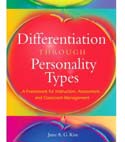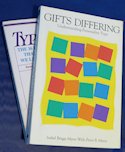
- About the MBTI
- Verify Your MBTI Type
- Personality Patterns
- MBTI Articles & Resources
- Article Directory for Educators & Students
- Books on Personality Types
- Emotional Intelligence & Personality Type
- Career Planning & MBTI
- MBTI Business Applications
- Lenore Thomson - Carl Jung Personality Type
- Site Map - Master Directory of All Articles
- MBTI Consultant Links
- Personality Type Workshops & Conferences
- Links to Other Type Websites
- Murder Mystery Business Theatre
- About Us
| 1 | 2 | 3 |
Articles on MBTI ® & Personality Type applications: Personality Type in Education
Are They Really Problem Students? Bridging Differences through Understanding
By Jane Kise, Ed. D., and Beth Russell, Ed. D.
(jane kise' preferences are infj; beth russell's are enfj)
Chances are, you’ve heard complaints about students who:
- Blurt, squirm, poke, or pester
- Ask too many questions
- Refuse to work, claiming that a teacher doesn’t like them
- Constantly miss homework deadlines
|
Often, the next statement is, “What’s wrong with this kid?” But there may not be anything wrong—the problem may be a personality clash. As one teacher put it, “What I thought were student deficiencies were a matter of my style. Often I can change something small in my classroom that makes a big difference in helping them be successful.”
Currently, we are introducing personality type concepts at an urban middle school where nearly two-thirds of the students receive reduced or free lunches. Approximately 70% are students of color, mostly African American and Hmong. In this climate, looking at preferences for learning points to ways in which diverse people are actually similar, building pathways for understanding.
While many personality frameworks offer insights into differences among people, one of the most well-researched is Jungian type theory, best known through the Myers-Briggs Type Indicator® tool (MBTI). This theory holds that people take in information and make decisions differently, two key processes in education. Further, these variations in behavior are quite orderly and consistent.
Often, educators say that they have “done” the MBTI ®before, but there is a difference between “doing” type and actually “experiencing” how people with different preferences view classroom dynamics, assignments, relationships and other areas that are as vital to education as what is actually taught. We provide hands’-on exercises and lesson plans that allow teachers to experience the different preferences in their classrooms.
At Dr. Russell’s previous school, weekly staff development meetings were available to introduce personality type preferences to the entire staff at once. Teachers reported that using the concepts improved student motivation and work quality. Because of limited staff development time at Dr. Russell’s current school, we decided to use a pilot program approach. One team of four 6th grade teachers volunteered to learn about personality type, incorporate it into their classroom management and lesson planning techniques, and introduce their students to the concepts.
After a semester, the attendance rates for the students assigned to the pilot team were better than for the other 6th grade team. Further, when asked to identify which of their 130 students the teachers knew well, the pilot team listed only four with whom none of them had a significant relationship, while the other team listed 25 students. Thus the training seems to be helping teachers build relationships with their students, a crucial step in the learning process.
As the year continued, the teachers worked to adapt lesson plans, assignments and assessments for the learning styles of students with different personalities. Teachers saw significant increases in student engagement and performance with the new lesson plans. The following chart compares results on two projects in language arts:
| Project not designed using type concepts |
Project designed using type concepts |
|
| % of students who received an “F" | 26% | 8% |
| % of students who received >75% | 58% | 70% |
| % of students who received >85% | 32% | 55% |
| % of students who received >95% | 9% | 36% |
Furthermore, the Language Arts teacher reported that there were close to no behavior problems in her classroom while students worked on the project she created using type concepts that took into account the students’ personalities and learning styles.
> > > Next Page: The Importance of Personality Preferences in the classroom
® MBTI, Myers-Briggs, Meyers Briggs, and Myers-Briggs Type Indicator are registered trademarks or trademarks of the Myers-Briggs Type Indicator Trust in the United States and other countries (aka meyers briggs or myers briggs).
© Published by Ross Reinhold & Reinhold Development 1997 - 2023
Privacy Policy About Us



